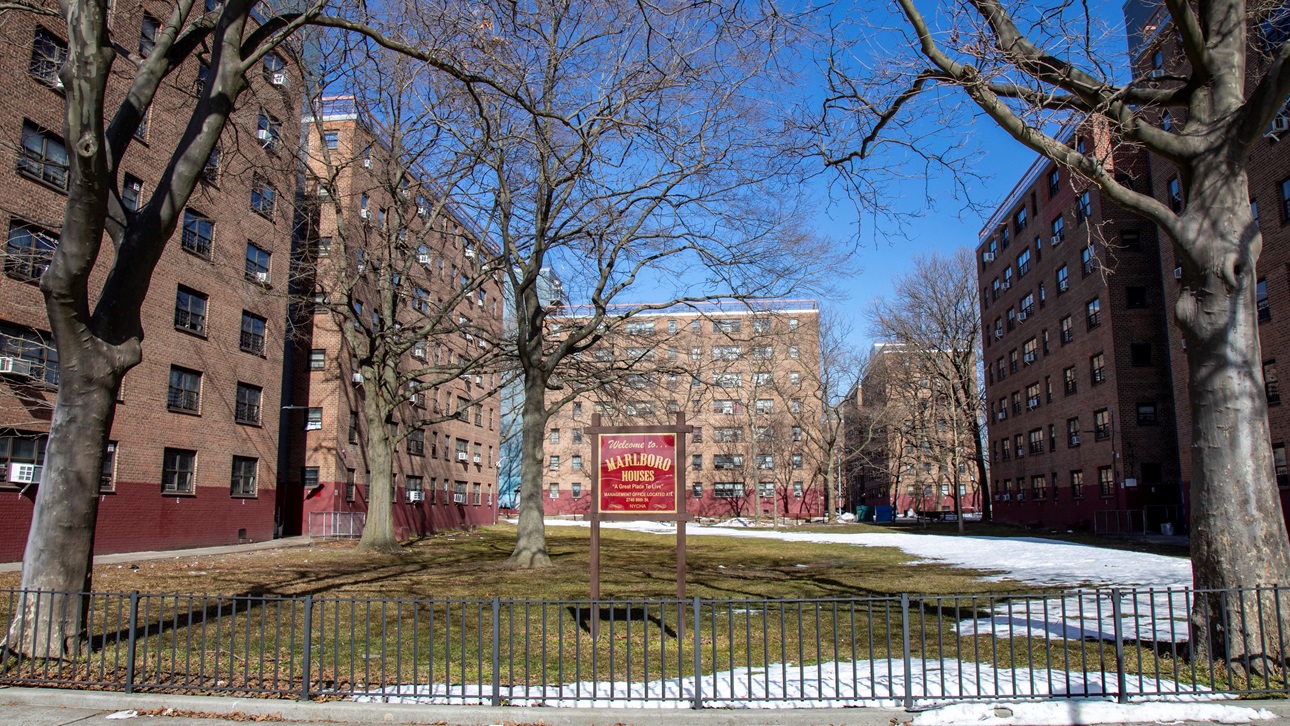Brooklyn, NY: Resilience in NYCHA’s Marlboro Houses

A Resilient Land Use Cohort (RLUC) Virtual Technical Assistance Panel
Background and Assignment
Ever since the damage caused by Hurricane Sandy in 2012, the New York City Housing Authority has been prioritizing hazard and resilience planning for its developments to better adapt and prepare for future climate-related hazards and extreme events. As part of this effort, in February 2021, NYCHA requested a ULI Technical Assistance Panel (TAP) to closely examine how one of its developments, Marlboro Houses, could be made more resilient to climate-induced hazards.
Marlboro Houses is home to over 4,000 New Yorkers across 28 residential buildings and is situated in the Gravesend neighborhood of south Brooklyn. Due to its semi-coastal location, flooding, storm surges, and their related adverse socioeconomic effects present a pressing challenge for the livability of the development and its residents. Additionally, extreme heat exposure is the deadliest hazard in the US and poses immediate risks to the health of residents at Marlboro while also burdening the development’s energy infrastructure and cooling capabilities. Despite these climate risks and vulnerabilities, panelists identified unique and impactful avenues to build resilience to multiple hazards.
Key Recommendations
- Enhance Marlboro’s landscape assets using green infrastructure to reduce the urban heat island effect and support stormwater management, and explore a neighborhood-wide green infrastructure strategy with other stakeholders to further reduce heat and flood risks.
- Pursue net zero/passive house and floodproofing building retrofits to maximize Marlboro Houses’ potential to offer healthy, resilient, and net zero carbon affordable housing while minimizing exposure to extreme heat and poor air quality.
- Create a long-term resilience plan and prioritize key data and information to guide future investment and management decision-making to ensure that both short- and long-term resilience needs of residents are being met.
- Utilize NYCHA’s upcoming organization-wide funding strategies to cover costs of resilience measures.
The panel’s deliberations, briefings, and interviews highlighted significant potential impact not only for Marlboro but other developments in NYCHA’s portfolio, as well as similar affordable housing development across the country. In considering the TAP’s recommendations as one cohesive initiative, panelists emphasize that there is a unique opportunity to ensure a more resilient and healthy place to live at Marlboro Houses and beyond.
This vTAP is part of an advisory services, technical assistance, and peer learning program called the Resilient Land Use Cohort (RLUC) that encourages enhanced resilience to climate change and related environmental and social vulnerabilities.
Report Summary: Background and Assignment
Ever since the damage caused by Hurricane Sandy in 2012, the New York City Housing Authority has been prioritizing hazard and resilience planning for its developments to better adapt and prepare for future climate-related hazards and extreme events. As part of this effort, in February 2021, NYCHA requested a ULI Technical Assistance Panel (TAP) to closely examine how one of its developments, Marlboro Houses, could be made more resilient to climate-induced hazards.
Marlboro Houses is home to over 4,000 New Yorkers across 28 residential buildings and is situated in the Gravesend neighborhood of south Brooklyn. Due to its semi-coastal location, flooding, storm surges, and their related adverse socioeconomic effects present a pressing challenge for the livability of the development and its residents. Additionally, extreme heat exposure is the deadliest hazard in the US and poses immediate risks to the health of residents at Marlboro while also burdening the development’s energy infrastructure and cooling capabilities. Despite these climate risks and vulnerabilities, panelists identified unique and impactful avenues to build resilience to multiple hazards.
Key Recommendations
- Enhance Marlboro’s landscape assets using green infrastructure to reduce the urban heat island effect and support stormwater management, and explore a neighborhood-wide green infrastructure strategy with other stakeholders to further reduce heat and flood risks.
- Pursue net zero/passive house and floodproofing building retrofits to maximize Marlboro Houses’ potential to offer healthy, resilient, and net zero carbon affordable housing while minimizing exposure to extreme heat and poor air quality.
- Create a long-term resilience plan and prioritize key data and information to guide future investment and management decision-making to ensure that both short- and long-term resilience needs of residents are being met.
- Utilize NYCHA’s upcoming organization-wide funding strategies to cover costs of resilience measures.
The panel’s deliberations, briefings, and interviews highlighted significant potential impact not only for Marlboro but other developments in NYCHA’s portfolio, as well as similar affordable housing development across the country. In considering the TAP’s recommendations as one cohesive initiative, panelists emphasize that there is a unique opportunity to ensure a more resilient and healthy place to live at Marlboro Houses and beyond.
This vTAP is part of an advisory services, technical assistance, and peer learning program called the Resilient Land Use Cohort (RLUC) that encourages enhanced resilience to climate change and related environmental and social vulnerabilities.


